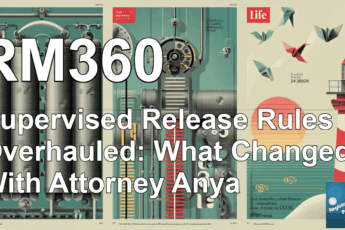Introduction:
In a move that has alarmed justice reform advocates, civil rights experts, and those with lived experience in the penal system, the U.S. Department of Justice (DOJ) has abruptly terminated funding for the National Prison Rape Elimination Act (PREA) Resource Center. This decision, announced in a brief notice and confirmed by multiple organizations, signals a radical shift in federal priorities around prisoner safety and accountability.
For over a decade, PREA and its supporting structures have been the backbone of efforts to combat and prevent sexual violence in American correctional facilities. The sudden withdrawal of support has sparked outrage from those who say this leaves some of society’s most vulnerable people exposed to harm, with little recourse or oversight. But why was PREA established in the first place, what does the end of its funding mean, and how did we arrive at this crossroads? In this article, we’ll explore the origins and impact of PREA, the decisions behind its defunding, the reactions from stakeholders, and, most importantly, what this means for the future of safety and accountability in U.S. jails and prisons.
Understanding PREA: Origins and Objectives
The Prison Rape Elimination Act (PREA) was enacted by the U.S. Congress in 2003. Notably, this wasn’t a piece of divisive legislation, but rather one of those rare laws passed unanimously—cutting across party lines to address a dire human rights issue. The central mission of PREA was straightforward yet profound: to analyze the incidence and effect of sexual violence within federal, state, and local correctional institutions, provide actionable resources, and set out recommendations and funding mechanisms aimed at protecting incarcerated individuals from sexual assault.
To support the execution of PREA, the DOJ established the National PREA Resource Center in 2010. This center became the nation’s hub for training, technical assistance, compliance auditing, and the consolidation of best practices. With these resources, correctional agencies and advocacy groups alike worked towards safer environments, transparent reporting mechanisms, and standardized responses to incidents of sexual abuse.
Key Functions of the PREA Resource Center included:
- Training Auditors and Staff: Equipping officials to identify, investigate, and prevent sexual abuse.
- Tracking Investigations: Monitoring progress and accountability in addressing sexual assault claims.
- Supporting Survivors: Providing resources and educational materials for those affected.
- Public Transparency: Offering a window into conditions inside prisons and raising awareness about the scale and severity of the issue.
The DOJ’s Shocking Shift: Why Was PREA Defunded?
The catalysts for this sudden defunding are complex and rooted in shifting federal priorities. According to a DOJ spokesperson, the department’s new focus is on “prosecuting criminals, getting illegal drugs off the streets, and protecting American institutions from toxic DEI and sanctuary city policies.” Consequently, programs like PREA that no longer align with these objectives became subject to funding review and, in this case, abrupt termination.
This change took immediate effect, with the DOJ ending support for the National PREA Resource Center and all related activities. Critics argue this decision signals the administration’s withdrawal from its statutory responsibility to safeguard those confined within the justice system—a claim underscored by reactions from a wide range of experts and advocacy organizations.
Reactions from the Field: Alarm Bells and Aghast Advocates
The PREA Resource Center’s closure reverberated quickly through the advocacy and justice communities. Impact Justice, which operated the center through a DOJ agreement, declared itself “heartbroken” over the move. The organization highlighted that PREA had enabled correctional facilities to meet their legal and moral responsibilities to protect people in their care, especially as incarcerated individuals are stripped of much of their personal agency and ability to protect themselves.
Mikaela Bowman, vice president and project adviser at Impact Justice, delivered a pointed statement:
“Defunding support for agencies… and the systems needed to operate the audit function suggests, dismayingly, that the DOJ abandoned its statutory responsibilities to protect the most vulnerable people in confinement from sexual abuse as required by PREA.”
Other organizations echoed similar concerns. Just Detention International, a prominent nonprofit dedicated to ending sexual violence in detention, labeled the cuts “devastating,” warning that carceral facilities would now be more dangerous for both adults and youth. Executive Director Linda McFarlane was especially blunt:
The shuttering of the National PREA Resource Center is quite simply catastrophic for incarcerated people… Its programs were a game changer for corrections agencies while also helping to shed light on the conditions inside prisons and jails across the country. Without the PREA Resource Center, corrections agencies will be left on their own when it comes to best practices to stop sexual abuse, and the public will be left in the dark about what goes on inside detention centers and facilities…the worst outcome is that the closure means incarcerated children and adults will be decidedly less safe.
Corene Kendrick, deputy director for the ACLU’s National Prison Project, warned that “actions by the Department of Justice to immediately zero out all funding for PREA investigations and audits will tragically make it more challenging to hold prison and jail officials responsible for the sexual assaults of people who they have locked up.” This lack of oversight, she argues, erodes accountability at every level.
Why PREA Mattered
PREA’s importance was not just in its symbolic value, but in the practical protection it afforded. Incarcerated individuals, by the very nature of their confinement, have limited ways to defend themselves, seek outside help, or even report abuse without fear of reprisal. As commentator Larry observed in the source discussion, “If we take away a person’s ability to defend themselves, we have to defend and protect them. That may cost money, folks… you’re depriving them of their freedom as punishment. You’re not depriving them of their life or of the sanctity of their sexual organs and their body.”
The practical value of PREA included:
– Standardized Regulations: All correctional facilities had to implement statutorily required measures to prevent and respond to sexual abuse.
– External Auditing: Regular external audits kept both public and private correctional agencies accountable.
– Survivor Support: Partnerships with local rape crisis centers gave survivors critical post-assault support.
– Education and Awareness: Training for both staff and inmates about their rights and ways to report abuse.
Perhaps most critically, PREA brought these practices into the national spotlight, making sexual violence in detention not just a hidden shame but a public policy and civil rights concern. As the Bureau of Justice Statistics has documented, sexual assault remains a persistent and underreported issue in jails and prisons—with young, vulnerable, or marginalized individuals most at risk.
The Impact of Defunding: What Happens Now?
With federal funding gone, the immediate concern is loss of uniformity and oversight. Facilities will now be left to devise their own approaches to preventing, investigating, and responding to sexual assault. For resource-strapped local jails or resistant state agencies, this may mean very little intentional effort or accountability.
Some predicted consequences include:
– Decreased Training: Fewer resources for staff and independent auditors mean lower-quality prevention and response.
– Less Transparency: The public will have less access to information about what happens inside facilities.
– Reduced Accountability: Without independent audits, “the fox is guarding the henhouse” again, so to speak.
– Increased Risk for Inmates: From naive, physically vulnerable young people to anyone lacking social support inside, risk rises where oversight evaporates.
Anecdotes from formerly incarcerated individuals echo these fears. Stories abound of young, inexperienced inmates exposed to hardened offenders with little that bystanders—or even well-meaning correctional staff—can do absent strong policy, resources, and enforcement.
As discussed in the source material, “You get some very naive, immature, and physically undeveloped 18-year-old that ends up in prison… bad things are going to happen to that kid.” Without PREA, the structures that offered at least some measure of protection or recourse will be severely weakened.
Looking Forward: Will States Step Up?
The federal withdrawal leaves a patchwork of local responses in its wake. Progressive states and institutions with strong commitments to human rights may try to maintain PREA guidelines on their own, funding programs and audits without federal support. However, history suggests that without incentives or pressure from Washington, many jurisdictions will do just enough to avoid lawsuits—or nothing at all.
Advocates argue this is precisely the wrong time to pull back. Reports from the Bureau of Justice Statistics and investigative organizations continue to reveal alarmingly high rates of sexual abuse in America’s prisons and jails. Additionally, the voices of survivors themselves remind us that sexual safety is not a luxury or privilege, but a basic human right—even, or especially, behind bars.
Conclusion: A Turning Point for Prisoner Safety in America
The defunding of PREA marks a pivotal—and, many say, dangerous—turn in U.S. criminal justice policy. It is not just a symbolic loss, but an immediate threat to the safety, dignity, and rights of hundreds of thousands of incarcerated people. With no federal mechanism left to enforce best practices, ensure transparency, or support survivors, the future is more uncertain than ever.
Actionable Takeaways
- Stay Informed: As citizens, journalists, and advocates, it’s essential to monitor and report on conditions in correctional facilities. The end of centralized oversight means more responsibility falls onto outside observers.
- Support Advocacy Groups: Organizations like Just Detention International and the ACLU continue to fight for reform and support survivors. Consider supporting their work or getting involved in local prison watchdog initiatives.
- Urge State Legislative Action: Contact your state legislators about the importance of maintaining strong standards and independent oversight for the prevention of sexual violence in correctional settings.
Final Thought:
The legacy of PREA is, ultimately, a test of our society’s commitment to human rights even for those who have lost their liberty. The next chapter—written by policymakers, advocates, and the public—will reveal whether that commitment endures or fades with the stroke of an administrative pen.
Sources Consulted:
– Direct commentary and insights from the Registry Matters podcast transcript (Andy and Larry)
– Press statements and reactions from Impact Justice, Just Detention International, and the ACLU National Prison Project
– U.S. Department of Justice materials on PREA
– U.S. Bureau of Justice Statistics surveys and recent reports
Added Context:
This article expands upon the source dialogue by providing historical background on PREA, statistical context, clarification of federal and local roles, and broader implications for public policy and human rights. For deeper research, consult the DOJ’s official PREA resources, Bureau of Justice Statistics reports, and investigations by organizations such as The Marshall Project and Human Rights Watch.



Leave a Comment